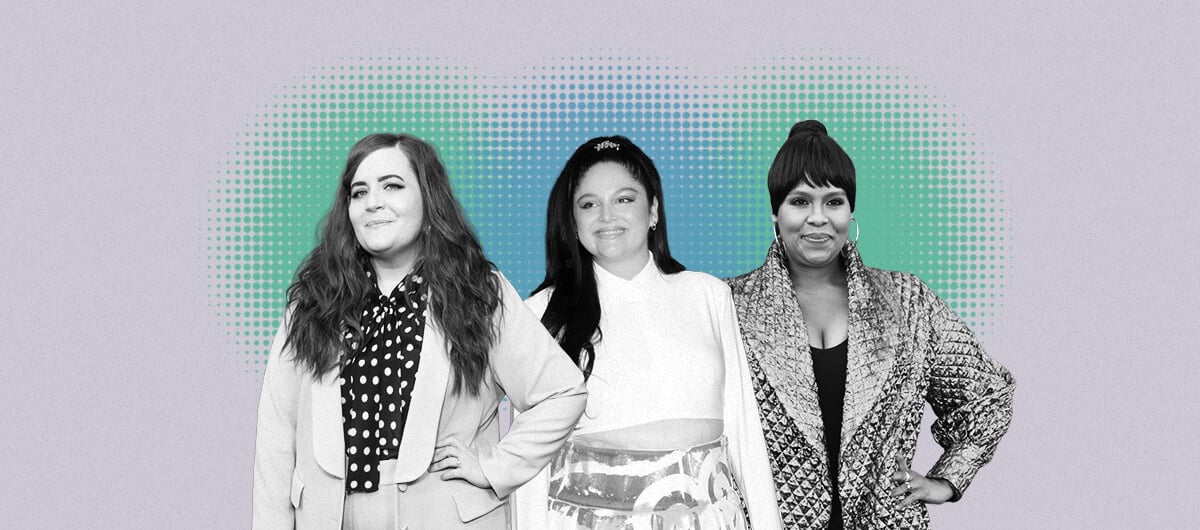

TV
What ‘Too Much’ Teaches Us About Writing Fat Characters
Inspired by the examples set by Lena Dunham, Natasha Rothwell, and Lindy West, award-winning TV and fiction writer Zoe Whittall offers indispensable advice about how to combat fatphobia on the page.
This article was made possible because of the generous support of DAME members. We urgently need your help to keep publishing. Will you contribute just $5 a month to support our journalism?
Recently, I read a headline that appeared in the British online magazine, Stylist U.K., declaring: “Netflix’s Too Much: It’s refreshing to see a plus-size lead whose story has nothing to do with her weight.” The article praises the way Lena Dunham’s new rom-com, Too Much, starring comedian Meg Stalter as its protagonist “Jess” never mentions her weight. The writer claims, in fact, that “her size is irrelevant.”
Too Much is about a 20-something woman, who, at a standstill in both her romantic and professional lives, moves to London from the Long Island home she shares with her grandmother and mother, and sister. I appreciated that Too Much avoided the usual tropes about fatness — Jess isn’t anyone’s sidekick, nor is she an insecure wallflower desperately focused on her diet. Yet it is inaccurate to say the story had nothing to do with her weight, unless you ignore the subtext. I’m a novelist, occasional TV writer, and a fat person who has lived in a body that has varied in size.
As I watched Too Much, it was immediately clear to me, even if I knew nothing about Lena Dunham, that the show was written by someone who has experience being fat, and/or respecting fat people. By not giving into exposition, the scenes unfolded the way they often happen in real life. The power dynamics involved when you place a fat character in a scene with thin people were still present. When Jess’s ex is cruel to her or she obsessively pores over the Instagram Reels of her ex’s social-media influencer girlfriend, or when she meets her new boyfriend’s skinny ex-girlfriend, the social capital of their bodies is present.
Too Much doesn’t pull a Schitt’s Creek and pretend we live in a world without prejudice. It not only acknowledges fatness, it nods to it in a sophisticated fashion. Too Much joins an extremely short list of shows where fat characters are treated with basic dignity, and allowed to have complex storylines. Natasha Rothwell’s How to Die Alone on Hulu — which was sadly canceled after one season — was a funny and smart series with a larger-than-Hollywood-norms main character. It was described as being about “a broke, fat, Black JFK airport employee who’s never been in love and forgotten how to dream.” Like Too Much, How to Die Alone allowed protagonist Mel to have the big dreams and the shitty love life of a normal human. Fatphobia — and racism and classism — is overtly acknowledged, but it doesn’t follow the usual fat girl tropes that have her trying to get skinny to get the guy, or change her life.
In the end, she does get the guy and she does change her life, but all without the thin person’s fantasy story arcs. In a Forbes profile, Rothwell tells fat activist Virgie Tovar that this was extremely intentional. “The world is screaming at me constantly that I don’t belong or that I’m too much, and so it would be impossible for that not to seep in. I just thought it would be interesting to be honest about that. And not in a way where [Mel is] going to lose 50 pounds, get the guy, and fly off into the distance.”
In both shows, Jess and Mel are treated with respect and interest by their lovers, and their romantic obstacles are both funny and real. And then there’s Shrill, an adaptation of Lindy West’s memoir of the same name that appeared for three seasons on Hulu, which starred the always funny Aidy Bryant. Shrill addressed fatphobia head on, but never in a way where you feel like you might be watching a TED Talk. (If you even mention the pool episode, I will cry, and I’ve seen it dozens of times.) In all of these shows there is simply no pandering to the status quo.
But all too many of the shows we watch and the books we read that feature fat characters only put forth the tropes or projections of a fatphobic writer. So we get the pathetic, fat secondary or tertiary characters that haunt, as an example, the critically praised fiction writer Ottessa Moshfegh’s thin narrators. Nearly every one one of Moshfegh’s books or short stories point out, in some way, that fat people are pathetic. Consider her award-winning novel Eileen, when she writes, “She was repugnant, I thought, in her fat and dishevelment … since she was overweight, I assumed she was an idiot.” This isn’t a stand-alone sentiment; it is repeated throughout Moshfegh’s work through the voice of many of her characters. It stands out as a particularly lazy narrative convention because her prose is otherwise so specific and sophisticated.
Similarly, onscreen, we’re to expect that the funny best friend or the always-dieting/self-hating person will eventually triumph through weight loss, the Single Sad, the idiot/slob, or the voraciously sexual. This is the problem with writers who project their worst fears about gaining weight and use wooden fat characters to make their main characters do or feel things about themselves. They are only walking failures, hack punchlines, or personal gurus, for the real people they hope the reader or viewer cares about.
We can learn a lot from these three shows, which have set new standards in portraying fat characters. Here are some questions to consider when writing a fat character:
- When you first write a parenthetical or physical description of their body, stop and ask: Am I just using their weight to show the reader that this person is weak, stupid, poor, gross, or unlikable? They might end up being some of those things, but is that the reason you’re describing them as fat? In Too Much, Jess’s body is not being used as a metaphor about consumerism or a lazy short-cut to spoon-feed a joke we’ve heard a thousand times.
- Is their fatness or body merely a punchline? It doesn’t mean they can’t be funny and joke about their bodies, but is that all they do? Is it the only point they serve? Too Much, Shrill, and How to Die Alone avoid this by having a fat main character, not just a sidekick with a handful of lines written only to make the main character look good in comparison.
- Does anyone want to sleep with them? Many fat people who are comfortable in their bodies do not have trouble finding partners — not everyone on Earth is attracted to the same body type. This is not to say your character can’t be lonely, hate their bodies, or experience discrimination while trying to date, but if your character is lonely because of their body and that is the whole story, then why not add some complexity, some truth?
- Are you writing a love scene where your thin character is disgusted by their partner’s fatness? Is the fat character unaware of their lover’s disgust? This is a fantasy scene, which is fine, if you want the disgust to be front and center from the POV of the thin person, but you have to offer more than the fact of it for the scene to make sense. I promise you that most fat people are incredibly sensitive to how others perceive them, especially someone who is propositioning them sexually, and it’s generally not hot for the fat person. Even if they have a humiliation kink.The fear-based fantasy that thin people have about hordes of fat people wanting to attack them with our voracious sexualities, or impose our bodies on them, is based on the idea that all fat people are out of control. It’s not a sign of radical, sophisticated, edgy writing to portray them this way as though it is Honest. It’s projection. I can tell when a writer has never had a fat friend who trusts them to tell them the truth. I often think, This writer doesn’t see fat people as having any value beyond the fetish or fear-based projection. Queer people know this feeling well as readers. But few consider a fat reader in the same way.
- Is your fat character out of control? Are they constantly eating and is this their only characteristic? The film The Whale is the worst example of this. As is “Fat Monica” on Friends. You get it. This is the reason fat people often feel uncomfortable eating in public.
- Your fat character does not have to be virtuous, always exercising and eating well, never flawed. You can go too far in the other direction and make all your fat characters perfect, that’s also bad writing! No one likes to be educated or talked down to. But consider that they should have the full humanity that you give your other characters. If they are only their bodies, only their fatness, then they are probably not working on the page or onscreen.
- You can write a fat character who can do or say anything — the sky is the limit. But ask yourself, do I think of fat people as real human beings? Do I have fat friends? When fat people talk to me, am I really listening? Am I looking behind them for someone with more social capital? Figure that out before writing about them.
- Is your biggest fear being a fat person? If so, work that out before you create a fat character and put them on the page or screen. If it was clear that a writer’s biggest fear was being queer, we probably wouldn’t praise them for hack-writing a queer character.
- Ask yourself: Is this joke hackish? Have I seen this scene a thousand times before? Would I make a thin person say this line? These are good questions to keep in mind.
- Would it be possible to cast one of your successful or ambitious or hard-working characters as fat? Fat people do not all think or feel the same things about their bodies, or about other fat people. But there are some common experiences we often share, especially if you also share other identities. There are reasons why a lot of people will eye-roll the same scene or choice of words or weak character descriptions. I’m merely suggesting writers give it more than passing consideration when conceiving of a fat character.
Before you go, we hope you’ll consider supporting DAME’s journalism.
Today, just tiny number of corporations and billionaire owners are in control the news we watch and read. That influence shapes our culture and our understanding of the world. But at DAME, we serve as a counterbalance by doing things differently. We’re reader funded, which means our only agenda is to serve our readers. No both sides, no false equivalencies, no billionaire interests. Just our mission to publish the information and reporting that help you navigate the most complex issues we face.
But to keep publishing, stay independent and paywall free for all, we urgently need more support. During our Spring Membership drive, we hope you’ll join the community helping to build a more equitable media landscape with a monthly membership of just $5.00 per month or one-time gift in any amount.




















































































